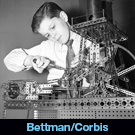Tales of Our Times—
The Leftover Parts Tell Truths
Dr. John Bartlit
New Mexico Citizens
for Clean Air & Water
Column of October 30, 2015, LA Daily Post
 The silvery toy in my early years was an Erector Set. The set had trays of assorted parts needed to build a child’s tractor, a movable seesaw or a Ferris wheel.
The silvery toy in my early years was an Erector Set. The set had trays of assorted parts needed to build a child’s tractor, a movable seesaw or a Ferris wheel. Political dialogue works much the same way. By choosing which parts to use and which parts to ignore, stories can be shaped to suit one’s fancy. Shelves are full of samples to see. Insights are found in a homely work problem assigned to student engineers in olden times, that is to say before clean water had evident value.
My bookshelf still holds chemical engineering books I used at Purdue, Class of ‘56. In my senior year, I took the course “Process Engineering Economics,” using a textbook with the same title. Flipping to the table of contents, I see that Section 7-4 teaches the fine points of “Nonproductive Investments and Taxes.” A worked example (pp. 184-87) illustrates how student engineers were trained in the 1950s. Caution: scholastic language ahead.
The sample problem is laid out: “A new food processing plant ... is so located that a waste disposal system is not necessary at the present time but might be desirable for esthetic reasons.” The step-by-step analysis proceeds to calculate payout times for an investment in a waste disposal system. It finds: “Both the economic and capitalized payout times for the capital investment without the waste disposal system are seen to be lower than with the addition.”
The student exercise concludes: “The preceding illustrates the rather important principle of the use of valuable capital (earning at 25 per cent) for a purpose which is nonproductive.” Able engineers of the day went forth and practiced the principles: Forget the waste disposal system. It earns no money.
A kitful of implications comes from the 1956 case. As kids choose toys, each of us can choose from the kit the parts for whatever story we like. The parts list reads:
- A. The text confirms that technologists and corporations get mired in concern for economic return.
- B. The textbooks today are far different from 60 years ago.
- C. The old text confirms that a worthy citizens’ lobby and government rules are essential. What else would change the old norm of neglecting the land, air and water to where we are today?
- D. The economics of process engineering yields a solid return on corporate investment, some of which provides the billions of dollars spent to make the air and water cleaner.
- E. Equipment that makes the air and water cleaner depends on engineering principles.
- F. Engineering economics yields a solid return for pollution control companies. These profits increase employment in the pollution control industry.
- G. The studied neglect of the environment is old school.
- H. Beyond government rules, self-initiated cleanup has advocates.
- I. A reliance on self-initiative helps the laggard companies and hurts the earnest ones. Plenty of entrepreneurs will abuse the freedom.
- J. Process engineering economics seeks high returns on investments. This aim matches the aims of popular pension plans.
Except in fairy tales read to children, facts do not fall neatly into lies and truth. Stating a truth is far different from telling the truth, the whole truth and nothing but the truth, which is the classic test we pretend to meet. Of course, telling the whole truth at every moment is an impossible bore.
Still, the most striking truth of all is how much sturdy truth is left out when arguing “the truth.”